Presentation Concepts for Conformal Navigation Systems
*Realisation and Evaluation of Conformal Navigational Arrows in a Conformal Head-Up DisplayThesis by: Leslie Klein
Advisor: Gudrun Klinker
Supervision by: Marcus Tönnis
Abstract
At present, various types of navigation systems are integrated into the car almost as a standard. While these systems promise to serve a valuable support, they represent a challenge by reason of being hazardous if interfering with the driving task. Although various improvements to reduce the driver ’s workload have been made during the last decades, they still face two common problems: On the one hand the driver has to take his eyes away from the street scenery to catch navigational information and on the other hand cognitive effort is required to interpret abstract metaphors on the navigation display and translate them to the real world. In this thesis we investigated Augmented Reality based techniques as a novel approach for user interaction in terms of navigation systems. This technology in combination with an integrated Head-Up Displays technology provides an attractive approach to augment the street scenery with conformal navigational aids. Conformal navigational aid’s are virtual elements (e.g. arrows) for route guidance information, which appear to be aligned with the street and are thereby seemingly integrated into the real environment. With this approach of displaying such navigational aids into the Head-Up Display, that these appear to be part of the street scenery a variety of new research challenges arise. In this work special attention is given to the graphical design and development of conformal visualization schemes and to the implementation of a system to evaluate the limitations of such schemes in terms of the design and technology. Furthermore the identification of indication limitations, induced by the optical setup, was considered to be of high importance. Thus a usability study has been performed to identify a distance threshold for conformal indication and whether this threshold can be influenced by the design of the presentation schemes.Research Challenges
- Conformal presentation of navigation information(Mock Up):
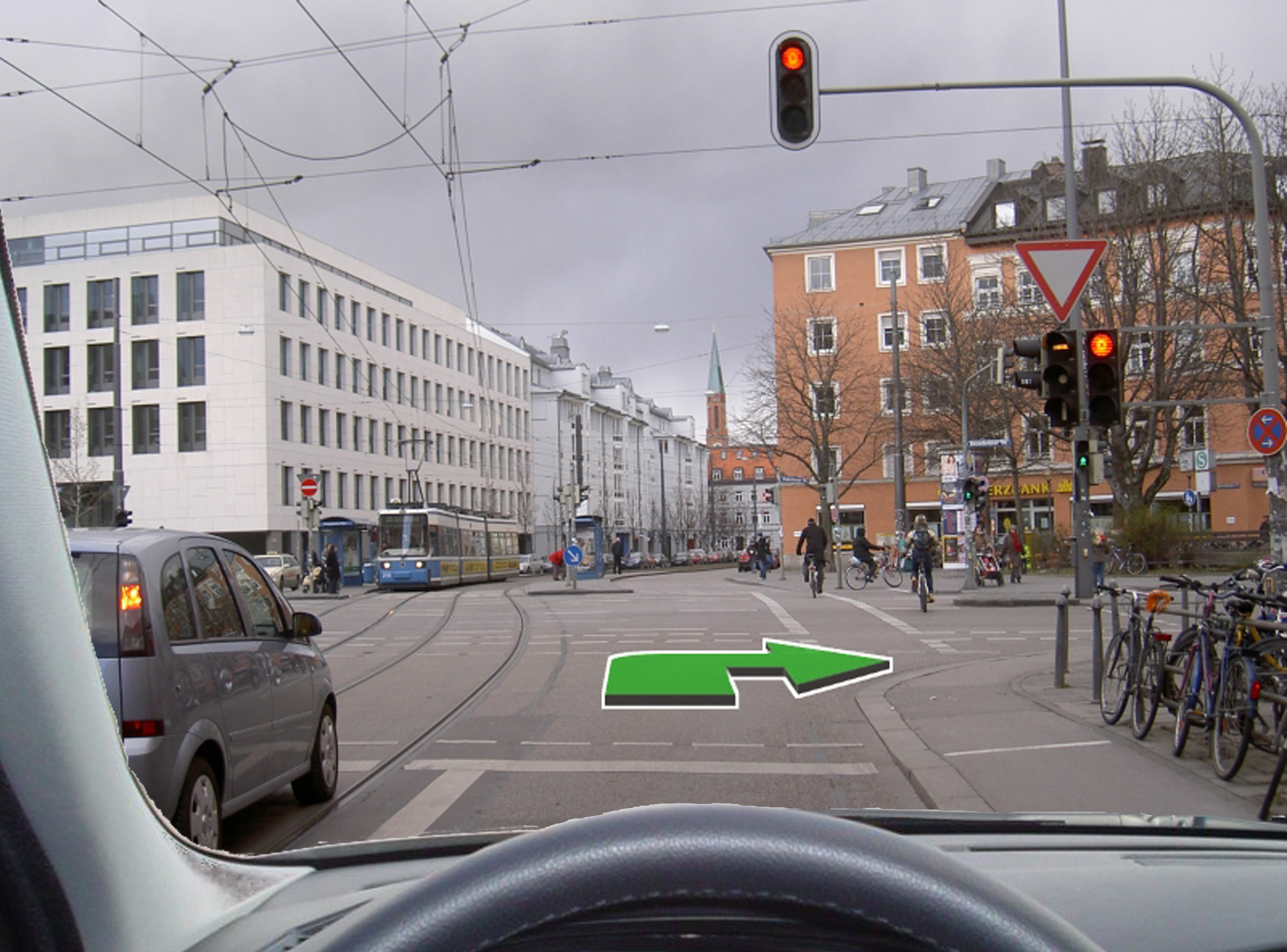
Display Constraints
Perception of depth: Virtual information has to be placeable at different distances to the driver. Since there is no possibility providing an adjustable focus depth, the display can only provide one fixed-focus depth. However, placing the image plane in specific distance to the driver is an approach to approximate to the required focal depth. Perceptibility in distance: With respect to the second mentioned issue there is a need that a wide range of possible indication distances can be covered. But the perceptibility of objects in distance is related to the spatial resolution of the display, which means displaying navigational aids at a great distance is limited to some extent.Design Constraints
Perception of depth: In terms of providing depth perception for location fixed arrows, some allusions can be provided by the design and rendering of the navigational aids. Which means supporting depth perception can be improved by cues which are inde- pendent of the display device. Perceptibility in distance: Design constraints concerning the improvement of percepti- bility of the given information are crucial and unfortunately at the same time elusive aspects of research. Up to now no research has been done to identify or define impor- tant aspects to enhance the perceptibility. Considerations which visualization scheme does achieve the highest perceptibility in distance can only be done in an intuitive way and have to be proofed. Intuitiveness: Providing intuitiveness of the provided information is complex issue, especially in the context of conformal indication, where no standards are set. Navi- gational aids must be designed efficient, easy to learn and satisfying to achieve the desired goal that concepts becomes easily understandable.Scope of this thesis
Design Concepts
Location Fixed Schemes
Location fixed schemes refer to the indication of placing the wayfinding aids directly on the maneuvering point within the environment. Such indication on it’s own is a promising solution to provide local guidance if the driver is in proximity but the driver has to be guided to the visible range of the maneuvering points. This either can be done through symbolic indication or by using one of the approaches mentioned beneath.Car Fixed Schemes
A further approach for applying conformal route guidance indication is an visualization of information aligned on the street, but seemingly fixed in front of the car. The indication gives evidence about the navigation path by heading towards the defined direction. Such schemes need additional information about the distance to the next turning point to enable the driver for anticipating the next maneuver.- Leading Arrow:

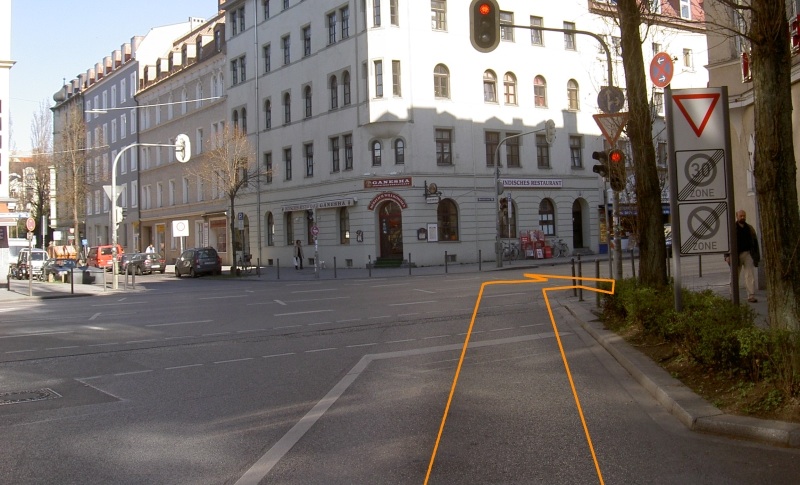
Hybrid Schemes
Location fixed indication on it’s own bears the risk of late or in worst case of none detection. Reducing the risk of late detection and furthermore to enable the driver to anticipate for the next turning maneuver when route information is out of sight postulates an overall solution. Either a combination with symbolic indication or a hybrid scheme of location and car fixed should be strived for.- Points on the Path:

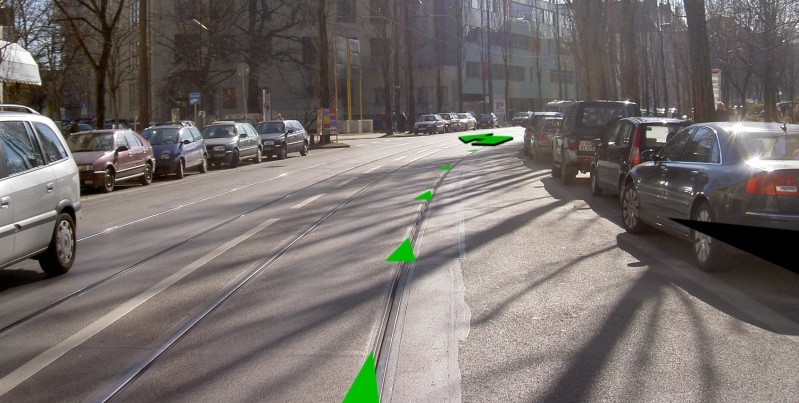
System Setup
- Optical Setup:
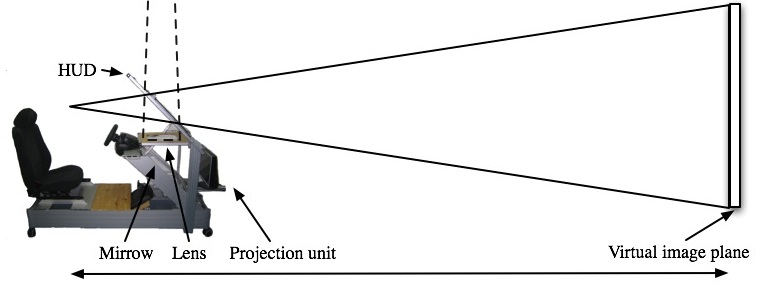
Usability Study
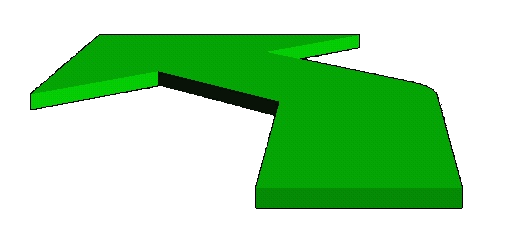
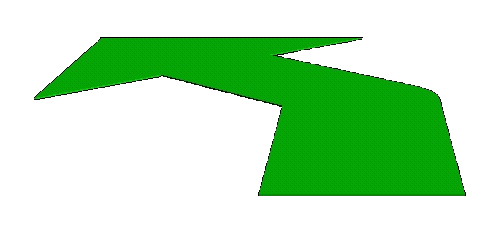

Presentations
- DA_KickOff2.pdf: Diploma Thesis Kick-Off Presentation
- DA_Final.pdf: Diploma Thesis Final Presentation
Diploma Thesis
- Thesis.pdf: Presentation Concepts for Conformal Navigation Systems
| Students.ProjectForm | |
|---|---|
| Title: | Presentation Concepts for Conformal Navigation Systems |
| Abstract: | Integrated into the car, Head-up Displays (HUD) enable information presentation in the driver's windshield. This display combined with Augmented Reality enables extension of the street scenery with conformal (location-fixed) navigation aids. Navigational arrows then appear to be aligned onto the street and seemingly integrated into the real environment. The presentation of route guidance information generates new challenges for investigation. The main reason for the application of HUDs lies in reduced glance times. The focal plane of HUDs therefore must reach large distances so that the human eye does not have to adjust to another focal depth when viewing from the street scenery onto the HUD. To achieve the desired focal length, but to keep the opportunity of information presentation in near distance, a conformal HUD has been built placing the focal plane in a distance of about 13 meters in front of the driver. The virtual projection screen became blown up to cover a wide field of view. This approach lead to a large relative size of screen pixels. This setup impairs the distance at which AR information can be displayed. A navigational arrow for instance will have to less pixels to be perceivable in large distances. The development of an application for preliminary studies to identify distance limitations for different conformal visualization schemes therefore is scope of this thesis. Different design concepts for AR navigation aids will be evaluted in terms of their perception in large distances |
| Student: | Leslie Klein |
| Director: | Gudrun Klinker |
| Supervisor: | Marcus Tönnis |
| Type: | Diploma Thesis |
| Area: | |
| Status: | finished |
| Start: | 2007/11/15 |
| Finish: | 2008/05/15 |
| I | Attachment   | Action | Size | Date | Who | Comment |
|---|---|---|---|---|---|---|
| | DA_Final.pdf | manage | 1567.4 K | 29 May 2008 - 12:26 | LeslieKlein | Diploma Thesis Final Presentation |
| | DA_KickOff2.pdf | manage | 587.4 K | 29 May 2008 - 12:21 | LeslieKlein | Diploma Thesis Kick-Off Presentation |
| | Thesis.pdf | manage | 3029.5 K | 06 Jun 2008 - 15:56 | LeslieKlein | Presentation Concepts for Conformal Navigation Systems |